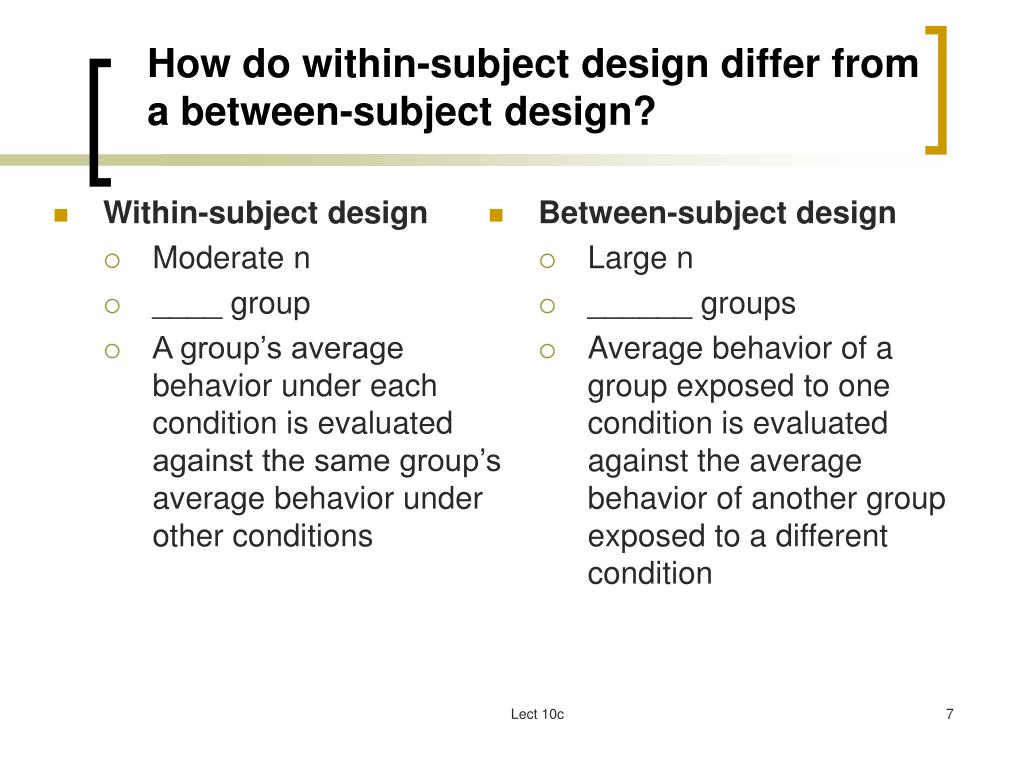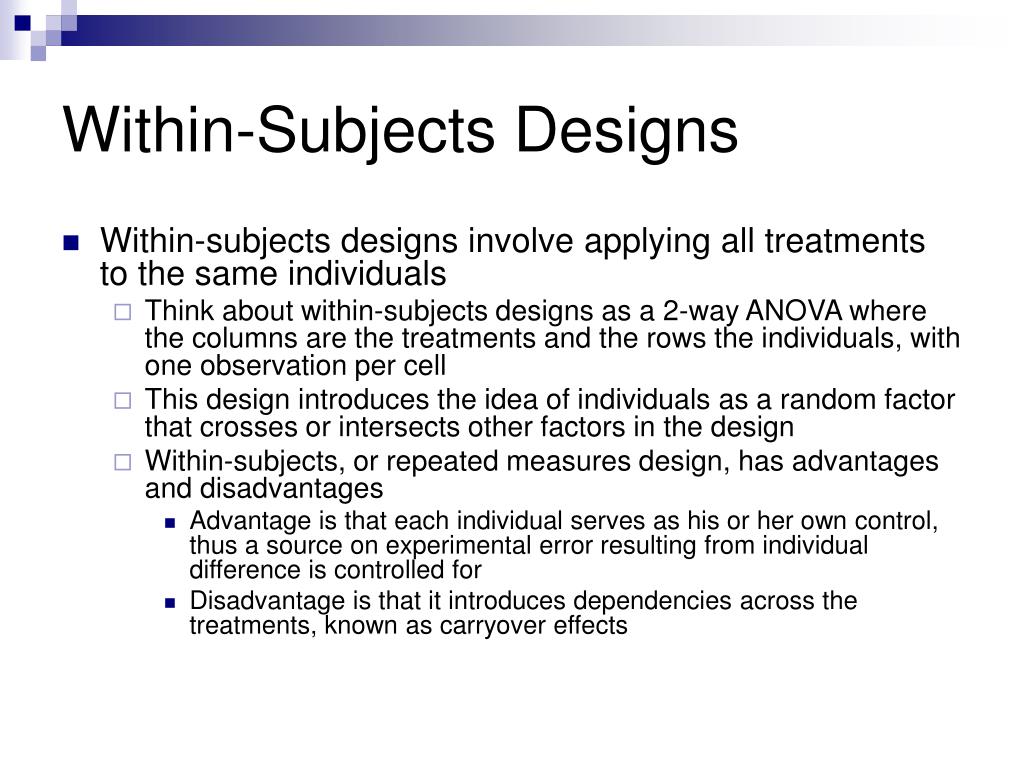Between-Subjects vs Within-Subjects Study Design
Table Of Content

Within-subjects designs require smaller sample sizes as each participant provides repeated measures for each treatment condition. A within-subjects design is also called a dependent groups or repeated measures design because researchers compare related measures from the same participants between different conditions. When it comes to non-academic research, between-subjects designs are beneficial because they offer more control and can save you vast amounts of time if you run multiple sessions simultaneously. However, because each subject experiences only one condition, either apples or oranges, the number of participants required to compare the two fruits increases; you need more participants.
Ways to assign conditions to test participants
In a between-subjects study design, also called independent-groups design, you expose each participant to only one condition of the independent variable. In this type of design, you will typically have a control group and one or more experimental groups. You should expose each experimental group to a variation of the independent variable, and the control group should have no treatment, a false treatment, or a placebo. You can then measure changes in the dependent variable between groups to gain insight into its relationship with the independent variable. A between-subject factorial design is an experimental setup where participants are randomly assigned to different levels of two or more independent variables.
Public Health Service Study of Untreated Syphilis at Tuskegee and Macon County, AL - Research Implications - CDC ... - CDC
Public Health Service Study of Untreated Syphilis at Tuskegee and Macon County, AL - Research Implications - CDC ....
Posted: Wed, 25 May 2016 23:38:26 GMT [source]
Methodology

One is that it controls the order of conditions so that it is no longer a confounding variable. Instead of the attractive condition always being first and the unattractive condition always being second, the attractive condition comes first for some participants and second for others. Likewise, the unattractive condition comes first for some participants and second for others. Thus any overall difference in the dependent variable between the two conditions cannot have been caused by the order of conditions. A second way to think about what counterbalancing accomplishes is that if there are carryover effects, it makes it possible to detect them.
Can I use a within- and between-subjects design in the same study?
This design allows researchers to understand the effects of two independent variables (each with two levels) on a single dependent variable. Researchers test the same participants repeatedly across all treatments to assess for differences between the variables. Within-subjects designs do not have a control group as all participants are tested both before and after they are exposed to treatment. The former are called between-subjects experiments and the latter are called within-subjects experiments. Between-subject and within-subject designs can be combined in a single study when you have two or more independent variables (a factorial design).
Between-Subjects vs. Within-Subjects Study Design
It’s a “needs assessment” that helps designers create more user-friendly products by integrating the user’s perspective into the design process. This can help your product or service stand out in the market and retain customers more effectively. Researchers then analyze these patients and collect data to test their anxiety levels. The psychiatrist can use this study to decide which medication is best for her patients with OCD. They will measure whether the groups differ significantly from each other due to the different levels of the treatment variable that they experienced.

Convenience sampling and quota sampling are both non-probability sampling methods. They both use non-random criteria like availability, geographical proximity, or expert knowledge to recruit study participants. Between subjects designs are invaluable in certain situations, and give researchers the opportunity to conduct an experiment with very little contamination by extraneous factors. Researcher Michael Birnbaum has argued that the lack of context provided by between-subjects designs is often a bigger problem than the context effects created by within-subjects designs.
Voxel-based morphometric brain comparison between healthy subjects and major depressive disorder patients in ... - Nature.com
Voxel-based morphometric brain comparison between healthy subjects and major depressive disorder patients in ....
Posted: Wed, 21 Jun 2017 07:00:00 GMT [source]
Researchers can use factorial designs to test multiple independent variables simultaneously. This experimental method combines individualized level of one independent variable with each of other independent variable to come up with varying conditions. In contrast, a mixed factorial design is where one variable is changed between subjects and extra within subjects.
Disadvantages of Between Subjects Design
Defining your variables, and deciding how you will manipulate and measure them, is an important part of experimental design. Different types of correlation coefficients might be appropriate for your data based on their levels of measurement and distributions. The Pearson product-moment correlation coefficient (Pearson’s r) is commonly used to assess a linear relationship between two quantitative variables. An experimental group, also known as a treatment group, receives the treatment whose effect researchers wish to study, whereas a control group does not.
Frequently asked questions about between-subjects designs
This makes it easier to control extraneous variables and increases the power of the study, since the same participants serve as their own controls. Between-subjects designs also prevent fatigue effects, which occur when participants become tired or bored of multiple treatments in a row in within-subjects designs. It’s important to consider the pros and cons of between-subjects versus within-subjects designs when deciding on your research strategy. While a between-subjects design has fewer threats to internal validity, it also requires more participants for high statistical power compared to a within-subjects design. The alternative to a between-subjects design is a within-subjects design, where each participant experiences all conditions. Researchers test the same participants repeatedly to assess differences between conditions.
Good face validity means that anyone who reviews your measure says that it seems to be measuring what it’s supposed to. With poor face validity, someone reviewing your measure may be left confused about what you’re measuring and why you’re using this method. While experts have a deep understanding of research methods, the people you’re studying can provide you with valuable insights you may have missed otherwise. This includes rankings (e.g. finishing places in a race), classifications (e.g. brands of cereal), and binary outcomes (e.g. coin flips).
A specific UX example of the differences between within-subjects design and between-subjects design can be illustrated through a typical A/B testing scenario. For a within-subjects study, the same group of participants would be shown both A and B variations. For a between-subjects design study, the participants would be separated into two different groups with one being shown the A variation, while the other is shown the B variation. If you test two variables, each level of one independent variable is combined with each level of the other independent variable to create different conditions.


Comments
Post a Comment